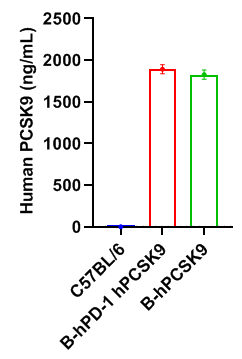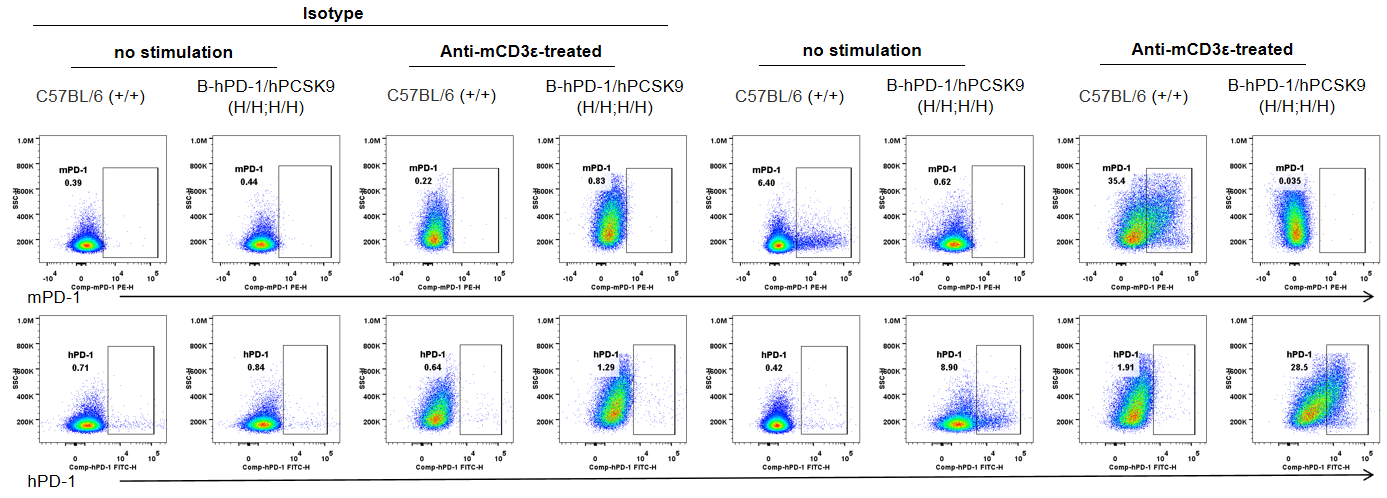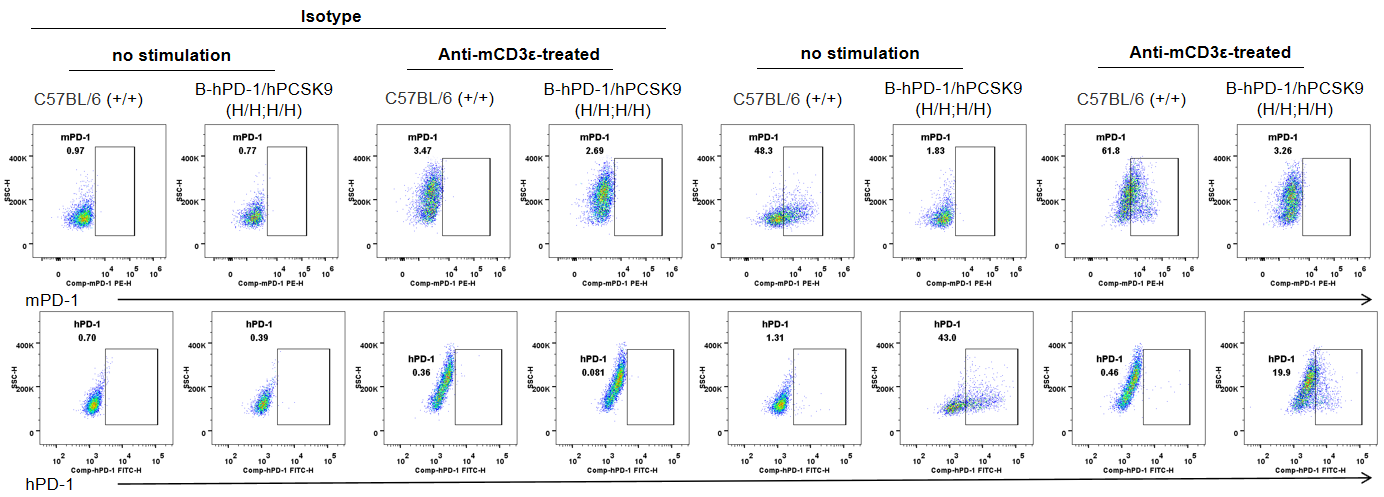Basic Information
-
Targeting strategy

-
Gene targeting strategy for B-hPD-1/hPCSK9 mice.
Exon 2 of the mouse Pdcd1 gene that encodes the lgV domain was replaced by human PDCD1 exon 2 in B-hPD-1/hPCSK9 mice.
Exons 1-12 of the mouse Pcsk9 gene that encode the full-length protein were replaced by human PCSK9 exons 1-12 B-hPD-1/hPCSK9 mice.
-
mRNA expression analysis

-

Strain specific analysis of PCSK9 mRNA expression in wild-type C57BL/6 mice and B-hPD-1/hPCSK9 mice by RT-PCR. Liver RNA were isolated from wild-type C57BL/6 mice (+/+) and homozygous B-hPD-1/hPCSK9 mice (H/H;H/H), then cDNA libraries were synthesized by reverse transcription, followed by PCR with human PCSK9 primers. Human PCSK9 mRNA was detectable only in homozygous B-hPD-1/hPCSK9 mice.
-
Protein expression analysis

-

Strain specific PCSK9 expression analysis in homozygous B-hPD-1/hPCSK9 mice by ELISA. Serum were collected from wild-type mice C57BL/6 mice (+/+) and homozygous B-hPD-1/hPCSK9 mice (H/H;H/H), and analyzed by ELISA with species-specific PCSK9 ELISA kit. Human PCSK9 was exclusively detectable in homozygous B-hPD-1/hPCSK9 mice and B-hPCSK9 mice but not in wild-type mice.

Strain specific PD-1 expression analysis in homozygous B-hPD-1/hPCSK9 mice by flow cytometry. Splenocytes were collected from wild-type C57BL/6 mice (+/+) and homozygous B-hPD-1/hPCSK9 mice (H/H;H/H) stimulated with Anti-CD3ε in vivo (7.5μg/mice, stimulation for 24h, i.p.), and analyzed by flow cytometry with species-specific anti-PD-1 antibody. Human PD-1 was exclusively detected in T cells in homozygous B-hPD-1/hPCSK9 mice but not in wild-type mice. Mouse PD-1 was detected only in wild-type mice.

Strain specific PD-1 expression analysis in homozygous B-hPD-1/hPCSK9 mice by flow cytometry. Splenocytes were collected from wild-type C57BL/6 mice (+/+) and homozygous B-hPD-1/hPCSK9 mice (H/H;H/H) stimulated with Anti-CD3ε in vivo (7.5μg/mice, stimulation for 24h, i.p.), and analyzed by flow cytometry with species-specific anti-PD-1 antibody. Human PD-1 was exclusively detected in CD4+ T cells in homozygous B-hPD-1/hPCSK9 mice but not in wild-type mice. Mouse PD-1 was detected only in wild-type mice.

Strain specific PD-1 expression analysis in homozygous B-hPD-1/hPCSK9 mice by flow cytometry. Splenocytes were collected from wild-type C57BL/6 mice (+/+) and homozygous B-hPD-1/hPCSK9 mice (H/H;H/H) stimulated with Anti-CD3ε in vivo (7.5μg/mice, stimulation for 24h, i.p.), and analyzed by flow cytometry with species-specific anti-PD-1 antibody. Human PD-1 was exclusively detected in CD8+ T cells in homozygous B-hPD-1/hPCSK9 mice but not in wild-type mice. Mouse PD-1 was detected only in wild-type mice.

Strain specific PD-1 expression analysis in homozygous B-hPD-1/hPCSK9 mice by flow cytometry. Splenocytes were collected from wild-type C57BL/6 mice (+/+) and homozygous B-hPD-1/hPCSK9 mice (H/H;H/H) stimulated with Anti-CD3ε in vivo (7.5μg/mice, stimulation for 24h, i.p.), and analyzed by flow cytometry with species-specific anti-PD-1 antibody. Human PD-1 was exclusively detected in Treg cells in homozygous B-hPD-1/hPCSK9 mice but not in wild-type mice. Mouse PD-1 was detected only in wild-type mice.
-
Summary

-
mRNA expression analysis:
The human PCSK9 mRNA was exclusively detected in homozygous B-hPD-1/hPCSK9 mice but not in wild-type C57BL/6 mice.
Protein expression analysis:
The human PCSK9 was exclusively detected in homozygous B-hPD-1/hPCSK9 mice and the expression level is similar to that in B-hPCSK9 mice.
The human PD-1 was exclusively detected in T cells, CD4+ T cells, CD8+ T cells and Treg cells in homozygous B-hPD-1/hPCSK9 mice.


